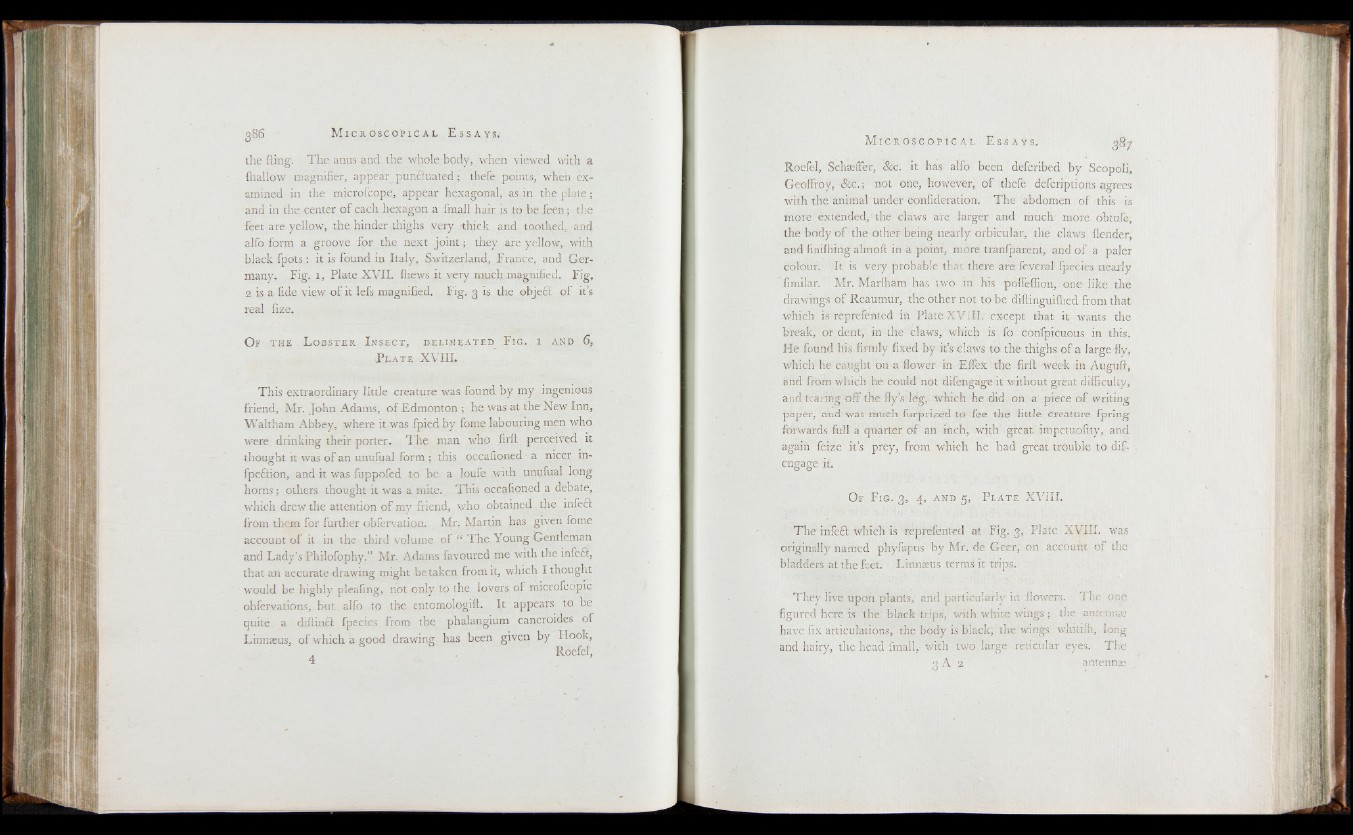
the fling. The anus and the whole body, when viewed with a
{hallow magnifier, appear punctuated; thefe points, when , examined
in the microfcope, appear hexagonal, as in the plate ;
and in the center of each hexagon a fmall hair is to be feen; the
feet are yellow, the hinder thighs very -thick and toothed,, and
alfo form a groove for the next jo in t; they are yellow, with
black fpots.: it is found in Italy, Switzerland, France, and Germany.
Fig. 1, Plate XVII. fliews it very much magnified. Fig,
2 is a fide view o f it lefs magnified. Fig. 3 is the obje£l of it’s
real fize.
O f t h e L o b s t e r I n s e c t , d e l i n e a t e d F i g . 1 a n d 6 ,
P l a t e XVIII.
This extraordinary little creature was found by my ingenious
friend, Mr. John Adams, o f Edmonton ; he was at the New Inn,
Waltham Abbey, where it was fpied by fome labouring men who
were drinking their porter. The man who firft perceived it
thought it was of an unufual form ; this occafioned a nicer in-
fpeftion, and it was fuppofed to be a loufe with unufual long
horns; others thought it was a mite. This occafioned a debate,
which drew the attention o f my friend, who obtained the infect
from them for further obfervation. Mr. Martin has given fome
account of it in the third volume of “ The Young Gentleman
and Lady’s Philofophy.” Mr. Adams favoured me with the infect,
that an accurate drawing might betaken from it, which I thought
would be highly pleafing, not only to the lovers o f microfcopic
obfervations, but alfo to the entomologift. It appears to be
quite a diftinft fpecies from the phalangium cancroides of
Linnaeus, of which a good drawing has been given by Hook,
, . Roefel, 4
Roefel, Schaeffer, &c. it has alfo been defcribed by Scopoli,
Geoffroy, & c . ; not one, however, o f thefe defcriptions agrees
with the animal under confideration. The abdomen o f this is
more extended, the claws are larger and much more obtufe,
the body of the other being nearly orbicular, the claws {lender,
and finiftiing almoft in a point, more tranfparent, and of a paler
colour. It is very probable that there are feveral fpecies nearly
fimilar. Mr. Marfham has two in his poffeflion, one like the
drawings of Reaumur, the other not to be diftinguifhed from that
which is reprefented in Plate XVHI. except that it wants the
break, or dent, in the claws, which is fo confpicuous in this.
He found his firmly fixed by it’s claws to the thighs of a large fly,
which he caught on a flower in Effex the firft week in Auguft,
and from which he could not difengage it without great difficulty,
and tearing-off the fly’s leg, which he did on a piece o f writing
paper, and was much furprized to fee the little creature fpring
forwards full a quarter o f an inch, with great impetuofity, and
again feize it’s prey, from which he had great trouble to difengage
it'.
Of Fig. 3, 4, and 5, Plate XVIII.
The infeft which is reprefented at Fig. 3, Plate XVIII. was
originally named phyfapus by Mr. de Geer, on account of the
bladders at the feet. Linnaeus terms it trips.
They live upon plants, and particularly in flowers. The one
figured here is the black trips, with white wings ; the antenna:
have fix articulations, the body is black, the wings whitifh, long
and hairy, the head fmall,- with' two large reticular eyes. The
q A 2 antennae